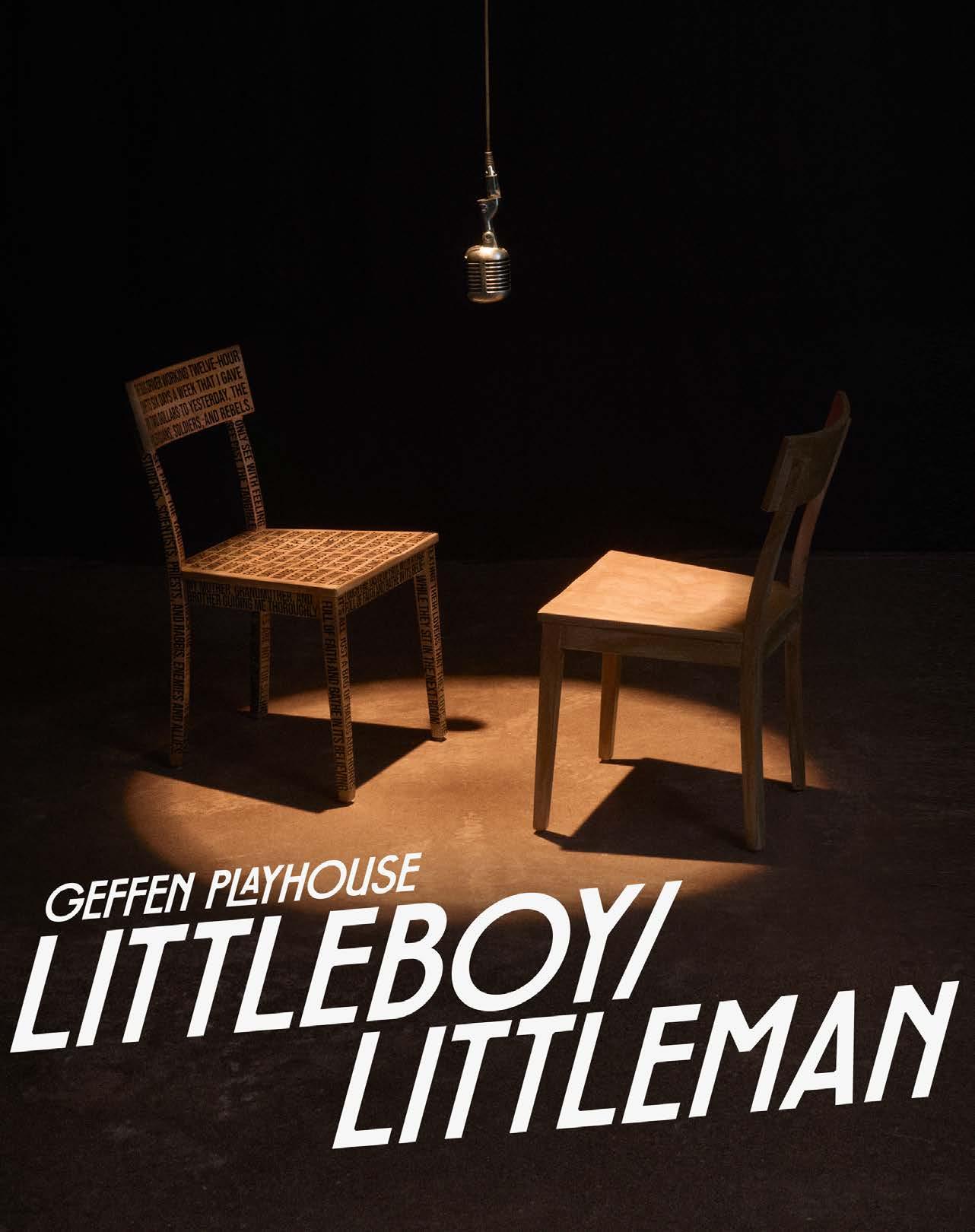

WORLD PREMIERE LITTLEBOY/ LITTLEMAN
10.01 – 11.02.2025
AUDREY SKIRBALL THEATER
Major support for this world premiere production provided by the Edgerton Foundation New Play Production Fund.
THANK YOU
Geffen Playhouse Education & Community Engagement programs are made possible, in part, by grants from Dwight Stuart Youth Fund and U.S. Bank Foundation
Geffen Playhouse’s High School Partnership Program is made possible, in part, by grants from the Kenneth T. and Eileen L. Norris Foundation and the Rosalinde and Arthur Gilbert Foundation
This guide is to be used for educational purposes only. Certain materials are included under the fair use exemption of the U.S. Copyright Law.
STUDY GUIDE COMPILED BY Brian Allman
COVER PHOTO BY Corey Olsen DESIGN BY Mark Chaitin
SPECIAL THANKS TO Brian Dunning, Isaak Berliner
EXECUTIVE STAFF & EDUCATION & COMMUNITY ENGAGEMENT STAFF
Tarell Alvin McCraney — Artistic Director
Gil Cates Jr. — Executive Director / CEO
Amy Levinson — Associate Artistic Director
Brian Allman — Director of Education & Community Engagement
Mark J. Chaitin — Manager of Education & Community Engagement
Paloma Nozicka — Education Associate
GEFFEN PLAYHOUSE TEACHING ARTISTS
Sean Michael Boozer, DeJuan Christopher, Paris Crayton III, Sidney Edwards, Margot Fitzsimmons, Aja Houston, Erròn Jay, BJ Lange, Tiffany Oglesby, Tara Ricasa, Ashley Robinson, Gerry Tonella
ACCESSIBILITY AT GEFFEN PLAYHOUSE
The theater has wheelchair and scooter-accessible locations where patrons can remain in their wheelchairs or transfer to theater seats.
OPEN CAPTION PERFORMANCE
An LED sign will display the Spanish text of the live production in sync with the performance. Español: Saturday, October 18, 2025 - 8:00 pm & Thursday, October 20, 2025 - 7:30 pm

ASL INTERPRETED PERFORMANCE
An ASL interpreter will be present in the house left. Sunday, October 26, 2025 - 2:00 pm
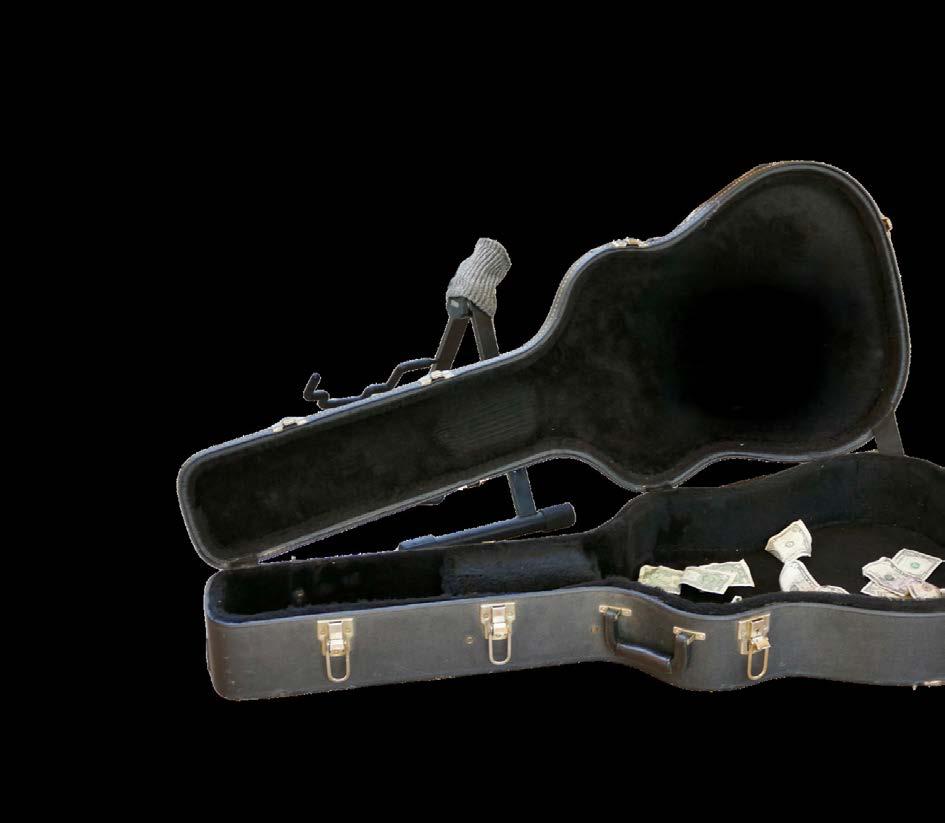

LUISVALLEART.COM
Scan the QR Code to the right to visit the Instagram of Luis Valle or El Chan Guri, aNicaraguan born visual artist living in Miami. When a civil war exploded 1979, Luis Valle’s family was exiled from my homeland of Nicaragua to Miami when he was just 2 years old. See more of his art at www.luisvalle.com
“LA SELVA” STREET MURAL FOR URBAN PALETTE PROJECT, MIAMI FL., PAINTED BY LUIS VALLE. PHOTO

LITTLEBOY/ LITTLEMAN
WRITTEN BY RUDI GOBLEN
DIRECTED BY NANCY MEDINA
PRODUCED IN ASSOCIATION WITH BRIXTON HOUSE
SCENIC DESIGNER TANYA ORELLANA
COSTUME DESIGNER SAMANTHA C. JONES
LIGHTING DESIGNER SCOTT BOLMAN
SOUND DESIGN BY UPTOWNWORKS—NOEL NICHOLS, BAILEY TRIERWEILER & DANIELA HART
COMPOSER RUDI GOBLEN
MUSIC DIRECTOR DEE SIMONE
DRAMATURG LAMAR PERRY
PRODUCTION STAGE MANAGER JULIET PARK

CAST

MARLON ALEXANDER VARGAS FÍTO PALOMINO

ASSOCIATE DIRECTOR VELANI DIBBA
MOVEMENT DIRECTOR CHRISTOPHER SCOTT
SPANISH TRANSLATOR ALBERTO E. MORALES
CASTING DIRECTOR PHYLLIS SCHURINGA, CSA
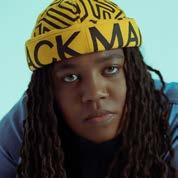

SIMONE DRUMMER
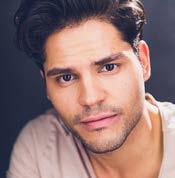
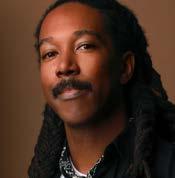
ROBERT LEE HART
ABOUT THE PLAY
OVERVIEW: When Nicaraguan brothers Fíto and Bastian clash over their visions of the American Dream, their choices send them on a collision course with fate—risking not just their futures, but their bond. Fíto, a poet, is impulsive and ambitious, willing to take risks to get what he wants. Bastian, a telemarketer, is steady and principled, holding onto caution as a guide. Blending poetry, live music, and ritual, this electrifying tale of brotherhood and belonging pulses with rhythm and emotion, pulling us into a world where family is everything, but dreams come at a cost.
S ETTING/TIME: Here. Now.
RUNNING TIME: 90 minutes, no intermission.
AGE RECOMMENDATION: 12+
WARNINGS: Strobe Lighting Effects • Loud Music • Theatrical Haze • Aisles Used for Actor Entrances & Exits
CONTENT ADVISORY: This production contains profanity.
ARTISTIC BIOGRAPHIES

RUDI GOBLEN Playwright (he/him)
Rudi is a playwright, educator, and performer who creates solo theater and devised theater work. He is a 2025 USA Fellow, a recipient of the Colman Domingo Award, a three-time winner of playwriting awards from The Kennedy Center, the Lorraine Hansberry Playwriting Award, and an O’Neill Finalist. His accolades include a Future Aesthetics Artist Award, two Miami-Dade County Choreographer Awards, and a FEAST Award for his book of poetry, A Bag of Halos and Horns. He has trained and worked with Cirque du Soleil and DV8 Physical Theatre and is a founding member of Teo Castellanos/D-Projects and Rosie Herrera Dance Theatre. Selected venues where his work has been presented include the Geffen Playhouse, The Shed, New York Theatre Workshop, Vineyard Theatre, the Fisher Center at Bard, Yale Cabaret, Alliance Theatre, and Rattlestick Theater. Publications include Theater Magazine, Imagined Theatres: Writing for a Theoretical Stage, Concord Theatricals, and PEN America. He holds an M.F.A. in playwriting from the Yale School of Drama.

NANCY MEDINA Director (she/her)
Nancy Medina is Artistic Director of Bristol Old Vic, taking the role in 2023. In October 2023 she directed her first production for the theatre, a revival of Tarell Alvin McCraney’s Choir Boy which received both Best Play and Best Director Awards at the Black British Theatre Awards in 2024. Further productions for Bristol Old Vic’s 2025 season included A Good House in co-production with the Royal Court Theatre and The Beautiful Future is Coming. As a director, her credits also include The Darkest Part of the Night (Kiln Theatre), Moreno (Theatre503), Trouble in Mind (National Theatre), The Half God of Rainfall (Fuel Theatre / Birmingham Rep / Kiln Theatre), The Laramie Project (Bristol Old Vic Theatre School), Two Trains Running (Royal & Derngate / English Touring Theatre), Strange Fruit (Bush Theatre), Collective Rage: A Play in 5 Betties (Royal Welsh College of Music & Drama), Yellowman (Young Vic), Curried Goat and Fish Fingers (Bristol Old Vic), and Dogtag (Theatre West). She is a recipient of 2024 Genesis Foundation Prize, 2020/2021 Peter Hall Bursary (National Theatre), 2018 Royal Theatrical Support Trust Sir Peter Hall Director Award (Royal & Derngate / English Touring Theatre), 2017 Genesis Future Director Award (Young Vic), and 2014 Emerging Director Prize (Tobacco Factory Theatres). She was a visiting director at the Bristol Old Vic Theatre School and was joint Artistic Director and founder of the Bristol School of Acting.
WHEN I THINK ABOUT LANGUAGE, I’M ALWAYS LIKE, HOW CAN I CREATE QUOTIDIAN LANGUAGE THAT TURNS INTO POETIC LANGUAGE, THAT TURNS INTO STYLIZED TEXT, THAT TURNS INTO RHYME, THAT TURNS INTO SOUND, THAT TURNS INTO MUSIC, THAT TURNS INTO MOVEMENT.
WE HAVE ALL THESE THINGS AVAILABLE TO US.
–Rudi Goblen, Playwright
BROTHERS ON BROTHERS
AN INTERVIEW WITH PLAYWRIGHT RUDI GOBLEN
SCAN THE QR CODE TO read an interview from the Geffen Playhouse Blog with Playwright Rudi Goblen and Dramaturg Lamar Perry, dramaturg for littleboy/littleman, where they discuss the process of developing the show and using humor to tackle the serious subject matter.
TO READ MORE INDEPTH ARTICLES & INTERVIEWS ABOUT PRODUCTIONS AT GEFFEN PLAYHOUSE VISIT: GEFFENPLAYHOUSE.ORG/BLOG

RUDI GOBLEN, PLAYWRIGHT, LITTLEBOY/LITTLEMAN.
PHOTO BY COREY OLSEN.
THE HISTORY & IMPACT OF BUSKING
If you’ve ever seen a guitarist in the park or a singer on the subway with a hat out for tips, you’ve seen a busker. Busking, or street performance, has been around for centuries, giving people free entertainment while letting artists share their craft and earn support.
The word “busk” comes from the Spanish word buscar, meaning “to seek” or “to look for.” (Tom 2022, para 2). Even though the word wasn’t common until the 1800s, busking is much older. In ancient Rome, musicians and actors filled the streets and festivals. Some performers used satire to mock politicians, which was risky—Roman law even punished performers who embarrassed powerful figures.
During the Middle Ages, traveling minstrels carried songs, dances, and stories across Europe, often exchanging performances for food and shelter. (Street performance, 2025)
Troubadours, who ranked higher socially, performed courtly love songs for nobility. Both groups helped spread culture, news, and entertainment across regions. (Troubadours, 2025)
Street performance also thrived in America. In the 1800s, circus acts, magicians, and musicians filled the streets and later influenced vaudeville. Medicine shows mixed skits and music with selling “cures.” Even Benjamin Franklin busked, singing in the streets and selling ballads he wrote. (Street Performers Buskers History Ben Franklin, n.d.)
Busking wasn’t limited to Europe and America. In Japan, chindon’ya troupes paraded in costumes with drums and flutes to advertise businesses. (Rosenstein, 2025) In India, Bhavai folk theatre used music, dance, and humor to entertain villages while criticizing social issues like the caste system. (Manohar Laxman Varadpande, 1987)
By the late 1800s, organ grinders and their dancing monkeys became symbols of busking. But because many were working-class immigrants, prejudice and noise complaints led to strict laws. London restricted street music in 1864, and New York banned it entirely in 1935—a ban that lasted until 1970. (Rosenstein, 2025)
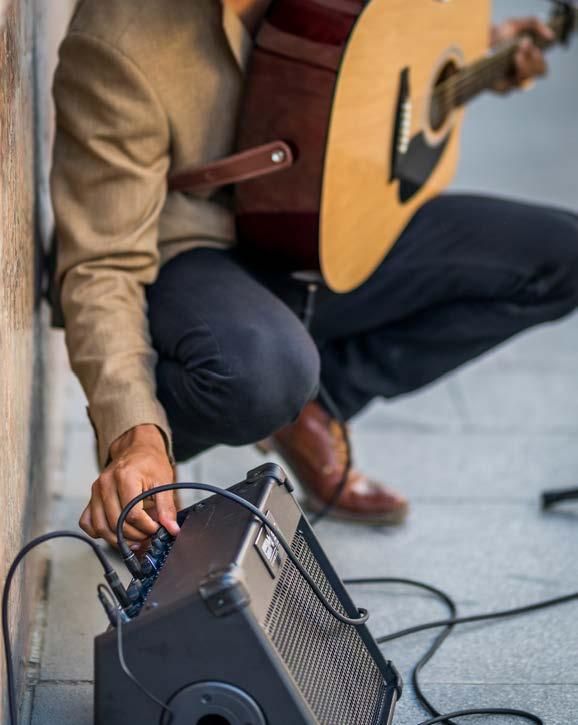
In the 1960s, busking re-emerged as part of the counterculture and hippie movement, especially during the “Summer of Love.” Today, technology has expanded busking into “cyber busking,” where artists perform online and collect tips digitally. This became especially important during the Covid-19 pandemic.
Busking has launched the careers of many famous artists, including Robin Williams, Tracy Chapman, and B.B. King. (Street performance, 2025). It continues to thrive in public spaces, even local places, like Santa Monica’s 3rd St. Peer & 4th St. promenade, where performers range from musicians and magicians to stunt bikers, comedians, and even bubble shows.
Busking makes art accessible to everyone while keeping streets lively and connected. It proves that creativity and culture can flourish anywhere—whether on a corner, a subway platform, or the Audrey Skirball Kenis Theater at Geffen Playhouse, where littleboy/littleman is being performed.
SOURCE: Busking A Short History - ToBusk. (2022, February 11). ToBusk. https://www.tobusk. com/blog/busking-a-short-history/ Manohar Laxman Varadpande. (1987). History of Indian theatre : Loka Ranya panorama of Indian folk theatre. Abhinav Publications.
Rosenstein, I. (2025, February 3). The Street as The Stage: The History of Busking. Berkshire Busk! https://www.berkshirebusk.com/post/the-history-of-busking
Street Performers Buskers History Ben Franklin. (n.d.). Www.buskersadvocates.org. http://www. buskersadvocates.org/saahistory.html#saafranklin
Wikipedia Contributors. (2023, June 12). Chindon’ya. Wikipedia; Wikimedia Foundation. Wikipedia Contributors. (2025, August 10). Street performance. Wikipedia; Wikimedia Foundation.
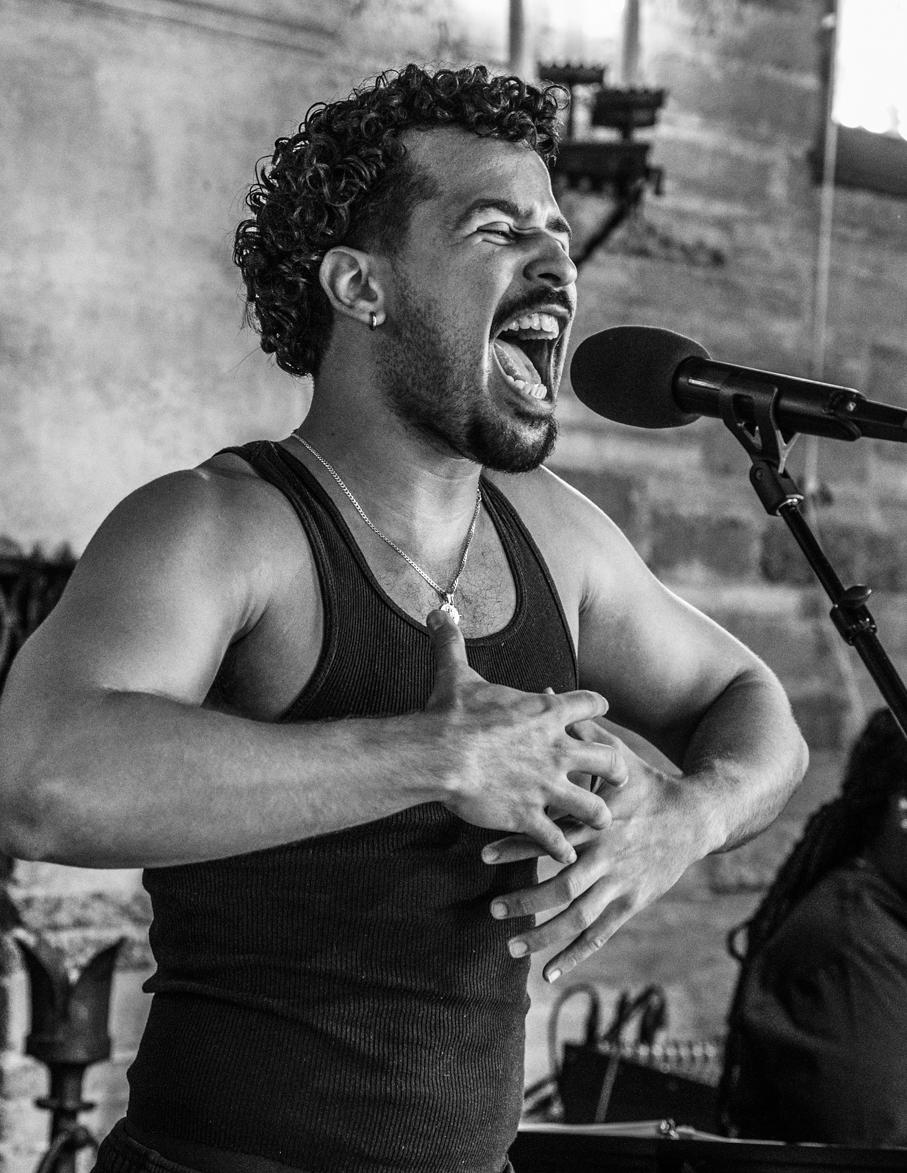
THIS PAGE: MARLON ALEXANDER VARGAS AND DRUMMER DEE SIMONE OPPOSITE PAGE: L-R: ALEX HERNANDEZ, DIRECTOR NANCY MEDINA (BACKGROUND), MOVEMENT DIRECTOR CHRISTOPHER SCOTT AND MARLON ALEXANDER VARGAS IN REHEARSAL FOR LITTLEBOY/LITTLEMAN AT GEFFEN PLAYHOUSE. PHOTOS BY JEFF LORCH.
BY BRIAN ALLMAN, GEFFEN PLAYHOUSE DIRECTOR OF EDUCATION & COMMUNITY ENGAGEMENT
Fíto Palomino, a poet and street performer, is the younger brother in Rudy Goblen’s littleboy/littleman . The show starts with Fíto amping up the crowd, getting them ready for his performance. He first shares with the anticipating audience the rules. He then asks everyone what time it is, informing them that it’s not only showtime, it’s POEM! TIME!
A poem is one of the main literary genres that distinguishes itself based on its structure and form. Poems are about expressing emotions and ideas. Poetry gives writers a way to share what they’re feeling or thinking about a topic in a way that connects with readers emotionally. It’s not always meant to be picked apart or analyzed—sometimes it’s just meant to be felt and experienced on a deeper, more personal level.
For this activity, on the next page, you will create a few acrostic poems. The structure of this type of poem is a fun and creative type where the first letter of each line spells out a word or message—usually vertically. That word is often the theme of the poem, and each line relates to it in some way.
For example, if the word is LOVE , each line starts with a letter from the word L-O-V-E, and the content reflects the theme of the word. It’s a great way to express ideas in a structured yet imaginative way.
The poem might look like this:
L ift your heart with gentle grace
O pen my mind to endless dreams

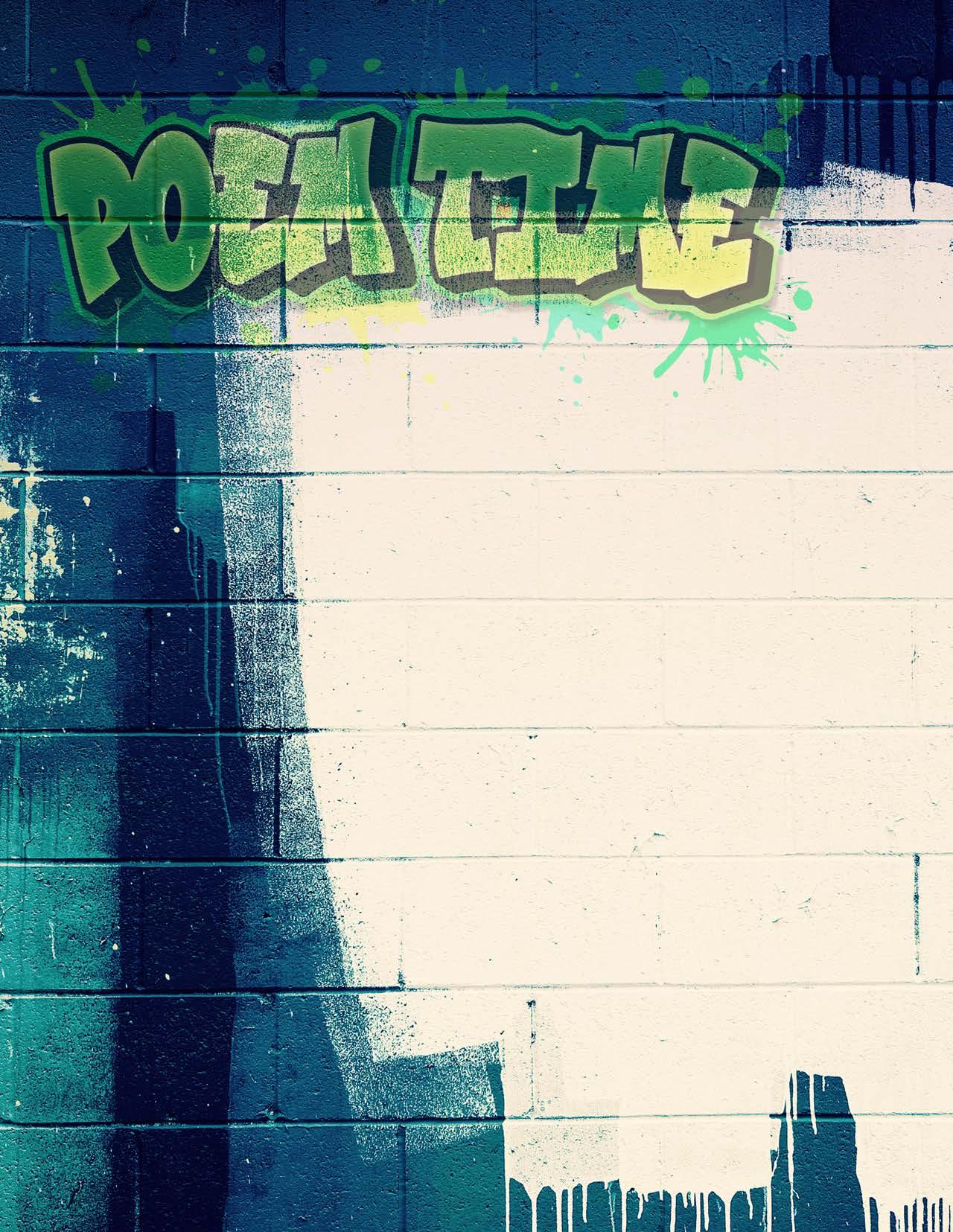
V alue moments that are big and small
E mbrace me with open arms
Scan the QR Code to the left to watch an interview with littleboy/littleman movement director Christopher Scott ( In The Heights, Wicked, Kiss of the Spider Woman ). Discover how he finds movement through the powerful words of his longtime friend and collaborator, Rudi Goblen.
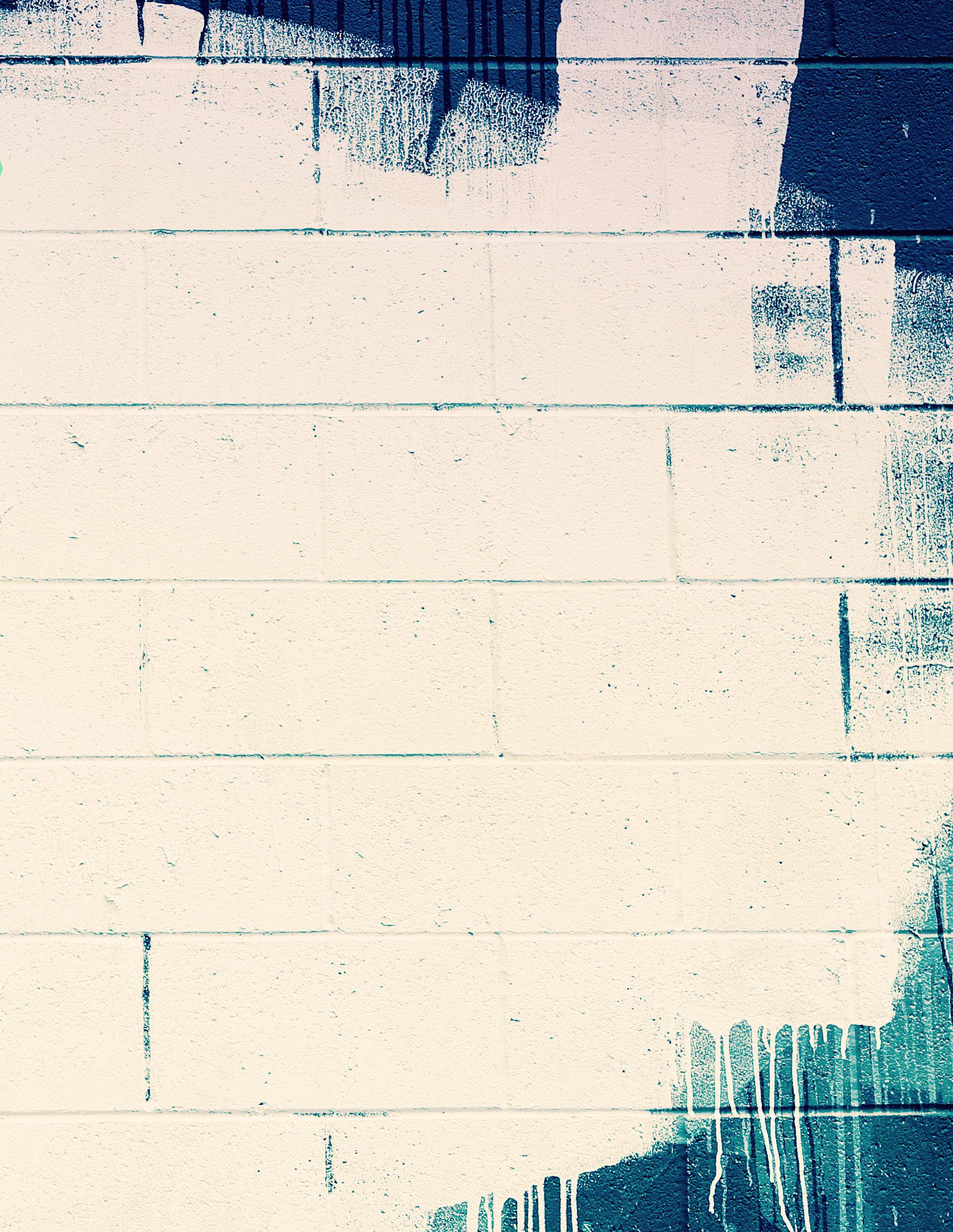
ACTIVITY:
DIRECTIONS: Choose one of the given words below, or choose your own word related to the show, and create an acrostic poem in the blank space below.
LOVE
PALOMINO BROTHERS
AMERICAN DREAM SWEETWATER
CHALLENGE: Write an acrostic poem for each of the words above.
PRACTICE: Be like Fíto , and practice performing your poetry aloud!
MUSIC: If you are musically inclined, add some original music and rythm to go along with your poem, and use the poem as lyrics.
MOVEMENT: Scan and watch the interview with littleboy/littleman Movement Director Christopher Scott on the previous page. Find your own movement inpsired by the words of your poems- and incorporate dance & movement!



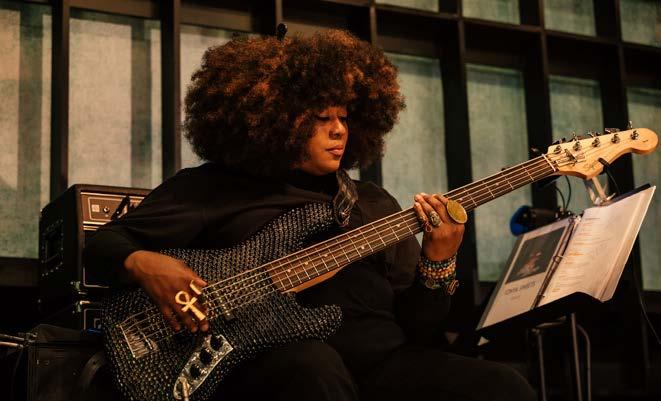
BASSIST TONYA SWEETS, MARLON ALEXANDER VARGAS AND DRUMMER DEE SIMONE & AUDIENCE. PHOTOS BY JEFF LORCH.

NICARAGUA
HISTORY, SOCIETY, & STRUGGLES
Nicaragua is the largest country in Central America, known for its volcanoes, lakes, and diverse cultures. It has a complex history shaped by colonialism, dictatorship, revolution, and, today, political repression.
The country gained independence from Spain in 1821. In the 20th century, Nicaragua experienced decades of dictatorship under the Somoza family, followed by a revolution led by the Sandinista National Liberation Front. Daniel Ortega, one of the Sandinista leaders, first became president in the 1980s and returned to power in 2007. He now rules alongside his wife, Vice President Rosario Murillo. Their government has grown increasingly authoritarian, concentrating power, limiting freedoms, and silencing critics.
Many Nicaraguans face censorship, loss of nationality, and forced exile. More than 5,600 non-governmental organizations and at least 58 media outlets have been shut down since 2018. Religious leaders, especially Catholic clergy, have also been imprisoned or forced out of the country for criticizing the government. Indigenous and Afro-descendant communities face repression and land disputes, echoing struggles for rights seen elsewhere in the Americas.
Nicaragua’s policies have even affected the United States. The country has become a major transit point for migrants from Latin America, the Caribbean, and beyond, many heading north toward the U.S. As a result, both the U.S. and European Union have placed sanctions on Nicaraguan officials for human rights violations.
Despite these challenges, Nicaraguans maintain a strong cultural identity, with traditions in poetry, music, and festivals that celebrate resilience. Like the United States, Nicaragua has a history of diverse communities, political debate, and people seeking freedom—though its current government makes that struggle much harder.
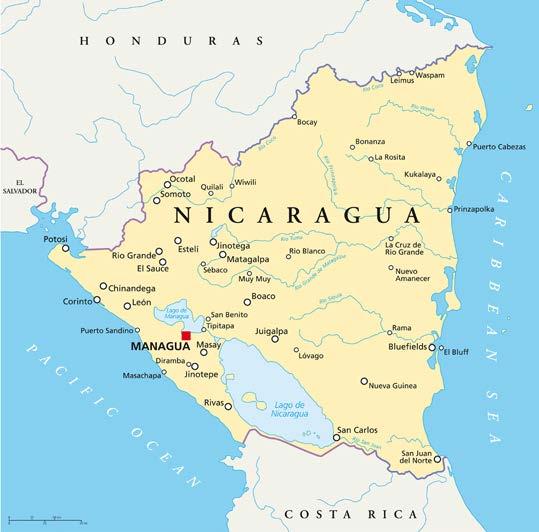

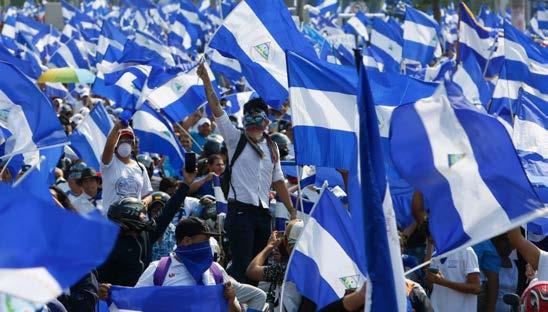
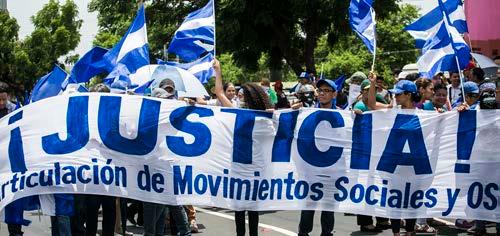
GOVERNMENT COMPARISON
Below is a side-by-side-by-side comparison that shows:
1. Nicaragua (Modern Context)
2. United States (Classical Ideals) — how the U.S. is traditionally taught in civics/government classes.
3. United States (Modern Context) — reflecting changes seen in the recent history of government & politics.

GOVERNMENT
RIGHTS & FREEDOMS
Power concentrated under President Daniel Ortega and Vice President Rosario Murillo; opposition repressed.
Freedoms of press, protest, and religion are severely restricted; many critics jailed or exiled.
Federal democracy with checks and balances; power divided among executive, legislative, and judicial branches.
Strong protections for speech, press, religion, and assembly guaranteed by the Bill of Rights.
The Federal system is still in place, but recent leaders have expanded executive power and tested institutional limits, raising concerns about democratic backsliding.
Rights remain on paper, but attacks on the press, limits on voting access, and efforts to overturn elections have raised doubts about how fully they are protected in practice.
RULE OF LAW & COURTS
POLITICAL STABILITY & VIOLENCE
Courts used to punish opponents; international bodies report rights abuses.
Independent courts safeguard laws and protect against abuse of power.
Ongoing repression, political prisoners, and exiles; widespread fear.
Peaceful transfers of power after regular elections are the norm.
Courts remain powerful but have shifted politically after many new judicial appointments; decisions on voting, reproductive rights, and presidential power show growing divisions.
Polarization has grown; the January 6, 2021, Capitol attack and election challenges revealed threats to peaceful transitions of power.
MEDIA & PRESS
Independent outlets closed; journalists harassed, jailed, or exiled.
A “free press” serves as a watchdog and holds leaders accountable.
INDIGENOUS & MINORITY RIGHTS
Indigenous and Afrodescendant groups face land seizures and violence.
Civil rights laws and movements protect minorities and expand equality.
A free press still operates, but leaders have labeled reporters as “enemies,” and lawsuits/ political pressure have chilled some reporting.
Legal protections exist, but systemic racism, voter suppression debates, and inequality continue to spark major national conflicts.
MIGRATION
Large numbers flee government repression and poverty; the country is a migration transit route.
U.S. seen as a “nation of immigrants” with opportunities for newcomers.
The U.S. is still a major migrant destination, but immigration has become one of the most divisive political issues, with frequent policy changes and border crises.
is changing the U.S. government. PBS News. https://www.pbs.org/newshour/show/democracy-advocate-examines-how-trump-is-changing-the-u-s-government Staff, E. (2016, August 22). 55 Interesting Facts About Nicaragua - Page 2 of 3. The Fact File. https://thefactfile.org/nicaragua-facts/2/ Tushar, A. (2022, October 2). 40+ Funny & Interesting Facts about Nicaragua that Wonder. Fact Packer. https://factpackers.com/interesting-fact-about-nicaragua/ U.S. Democratic Backsliding in Comparative Perspective. (2025). Carnegie Endowment for International Peace. https://carnegieendowment.org/research/2025/08/us-democratic-backsliding-in-comparative-perspective?lang=en Wikipedia Contributors. (2025, September 12). Nicaragua. Wikipedia; Wikimedia Foundation. Williamson, V. (2023, October 17). Understanding democratic decline in the United States. Brookings. https://www.brookings.edu/articles/understanding-democratic-decline-in-the-united-states/
NICARAGUA (Modern Context)
UNITED STATES (Classical Ideals)
UNITED STATES (Modern Context)

LEARN MORE: NICARAGUA
Scan the QR Code to the left to watch “Anthony Humbled by Two Sides of Nicaragua | Anthony Bourdain : No Reservations | Travel Channel .” Nicaragua is known to be full of hard-working individuals with a vast array of political ideologies. While here, Anthony visits locals young and old to find out what it means to live in Nicaragua today. Aired 3/14/2011
Scan the QR Code to the left to watch: “Nicaragua’s Democracy Crisis” from VICE on HBO Jan 10, 2020 from PBS. VICE’s Vikram Gandhi travels to Nicaragua to meet the new revolutionaries and find out what the future might hold for what was once one of the safest nations in Central America.

Scan the QR Code to the left to watch: “MY BEAUTIFUL NICARAGUA: A Short Documentary About Climate Change” BYkids by Edelsin Linette Mendez. Edelsin lives with her siblings and parents on their small coffee farm in the beautiful highlands of Nicaragua
Scan the QR Code to the left to read or listen to Perspectives “I returned to Nicaragua, where I was born, and found a country steeped in fear” by Eyder Peralta, published on NPR.ORG SEPTEMBER 14, 2023
Scan the QR Code to the left to read “How Susan Meiselas Documented Nicaragua’s Revolution” from Aperture.org. The photographer reflects on her experience working in Latin America and why it’s essential to revisit a body of work over time. Written by By Kristen Lubben February 14, 2025



THIS PAGE: CATHEDRAL AND CALLE LA CALZADA, GRANADA, NICARAGUA, PHOTO BY DON WHITEBREAD, ADOBE TOP PREVIOUS PAGE: GRANADA SKYLINE, NICARAGUA, PHOTO BY CISCO_96, ADOBE

RECIPE: BAHO
Baho, vaho or bajo, depending on languages and cultures, is a wonderful party dish from Nicaragua. It is the true cornerstone of the culinary influences of the country. Prepared with marinated beef brisket (but also sometimes with veal liver), plantains, yuca (cassava) and various vegetables, the whole dish is then steamed for a long time in banana leaves. The word baho itself means “to steam” in Spanish. This Nicaraguan dish mixes indigenous cultures with the Afro-Nicaraguan blend of the country. It is usually accompanied by curtido, a salad of raw vegetables with cabbages, tomatoes, vinegar and or lemon juice. This is the traditional dish that is almost always served for Sunday lunch. It is prepared on Saturday for the next day so that the flavors of the marinade combine perfectly. Baho is a particularly friendly experience because when family and friends gather on Sundays to enjoy it, everyone brings their favorite fresh fruits to accompany them. You start with a few glasses of passion fruit juice or rum served in fresh watermelons and then enjoy this hot dish, usually sitting in the garden.
Recipe from by Renards Gourmets on www.196flavors.com
PREP TIME: 45 min.
COOK TIME: 4 hrs.
REST TIME: 1 day
I NGREDIENTS:
4 lb beef brisket , cut into thin slices
4 lb manioc (cassava)
6 plantains , ripe
3 plantains , green
Banana leaves
2 cups bitter orange juice
5 cloves garlic , halved
5 large onions
1½ lb tomatoes , peeled, seeded and sliced
1 small red bell pepper , cut into slices
1 small green bell pepper , cut into
slices
Salt Pepper
Scan the QR Code to the left to watch “Top 3 Miami Nicaraguan Dishes You Need To Try!” from thePeroLike and Buzzfeed on Youtube!
DIRECTIONS:
1. Cut the onions in half.

2. Generously season the meat with salt and put it in a bowl.
3. Add the cloves of garlic, onions and juice of bitter oranges.
4. Marinate for 24 hours.
5. After the marinade, wash the meat very quickly to remove excess salt.
6. Cut the onions used in the marinade into thin slices.
7. Peel the cassava and all the plantains and cut them in half.
8. Line a large casserole with banana leaves, leaving them overhanging so that there is enough to cover the preparation, leaving no openings between the leaves: the water must not enter.
9. Then form 3 layers.
10. First add the cassava.
11. Then add the green and ripe plantains. Place them in a standing position (like ladyfingers when forming a charlotte).
12. In the space in the center, place the meat and cover with tomatoes, bell peppers and onions. Close the leaves over to close.
13. Add about 2½ cups (700 ml) of water around & boil for 2 hrs over medium heat.

14. Then reduce the heat and continue cooking for 2 hours. During cooking, add more boiling water if the water evaporates too much.
15. While cooking the meat, mix all the ingredients of the cabbage salad and keep it in a cool place.
16. Baho is traditionally served on a banana leaf.
17. Each serving consists of a piece of ripe plantain, a piece of green plantain, a piece of cassava and a portion of meat. The dish is finally topped with a portion of cabbage salad.
Scan the QR Code to the left to watch “A Sentimental Journey Through Nicaragua” A Taste of History Season 9 Episode 12 on PBS.org, Aired 06/18/2019. Joined by his son, Chef Walter Staib travels to his latewife’s homeland in this touching tribute. Nicaragua’s natural beauty, unique culture, and amazing cuisine are celebrated.

Scan the QR Code to the left to watch “Nicaragua Food Tour in the Nicaraguan Capital of America!” from DavidsBeenHere!




Experience the flavors of Little Nicaragua here in Miami, USA, the largest concentration of people from Nicaragua in the USA, From gallo pinto to vigoron, we’ll take you on a culinary journey through this vibrant neighborhood. Sep 10, 2024
VOCABULARY CORNER: IMMIGRATION
Immigration is the international movement of people to a destination country where they do not possess nationality in order to settle as permanent residents.
Immigration is a defining feature of our globalized world, shaping economies, cultures, and societies. Yet, the process of moving across borders is rarely straightforward. Navigating immigration systems involves a maze of legal requirements, expensive costs, shifting policies, and bureaucratic hurdles that vary widely from country to country, and is ever-evolving. Political climates, economic needs, security concerns, and humanitarian obligations all influence how nations manage immigration, often making the process both emotionally and logistically challenging for individuals and families. Behind every visa application or asylum request is a deeply personal story,intersecting with a web of international law and national interests. Below are a few key terms to understand the process.
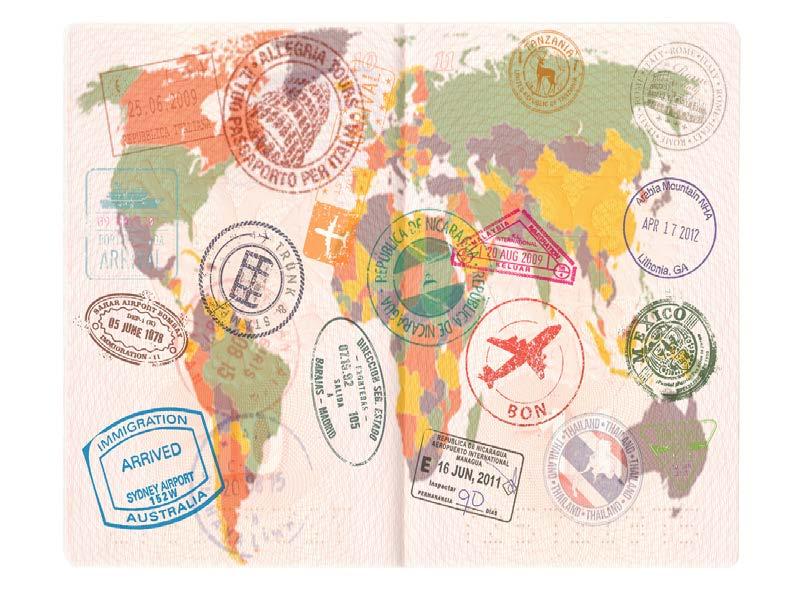
CITIZENSHIP – (noun) the status of being a recognized member of a country, either by birth or through other means.
NATURALIZATION – (noun) the process by which a non-citizen can become a citizen after meeting specific legal requirements, such as residency, language proficiency, and passing a citizenship test.
CIVICS – (noun) the study or science of the privileges and obligations of citizens. Civic education is the study of the theoretical, political and practical aspects of citizenship, as well as its rights and duties.
GREEN CARD (OR PERMANENT RESIDENT CARD) – (noun) a document issued by the government that grants the holder permanent resident status allowing the individual to live and work in that country indefinitely. In the U.S. it provides a pathway to citizenship after a specified period (typically 3-5 years). There are different types of green cards: Family-Based, Marriage-based Employment-Based, Humanitarian, Diversity Lottery, Longtime-Resident, and other.
REFUGEE – (noun) someone who fears or has experienced, persecution in their home country — because of their race, religion, nationality, political opinion, or membership in a particular social group, can lso be due to natural disasters, climate change, civil war, or political upheaval.
ASYLUM – (noun) a safe place. People persecuted by their own country often seek asylum in another country. An asylee is someone who has applied for, but not yet received, refugee status.
EMIGRATE & IMMIGRATE – (verb) to emigrate means to leave one’s country of origin, while to immigrate meanbs to come into a new country. Both of these words come from the Latin migrare (“to move from one place to another”).
IMMIGRANT – (noun) a person who comes to a country different than their country of origin to take up permanent residence.
VISA– (noun) an official authorization from a foreign country allowing a traveler to enter, transit through, or stay in that country for a specific purpose and period of time. Visas are granted by a country’s consulate or embassy abroad and are categorized in two types: Non-immigrant visas- temporary documents that allow the holder to visit for a specific amount of time with a clear departure datefor specific purposes, such as tourism, work, education, medical reasons or business trips, and Immigrant visas-this type of visa allows travel to the United States to live there permanently and is part of the process in getting a green card. This visa must be obtained prior to traveling to the United States, and the process for getting this type of visa is more extensive.
DIASPORA – (noun) the movement, migration, or dispersion of a people away from an established or ancestral homeland
SANCTUARY CITY – (noun) are jurisdictions that prioritize the safety and well-being of all residents by limiting cooperation with federal immigration authorities, allowing limited local resources to be used to support local community members. Sanctuary policies are often adopted in areas with large immigrant populations, and about a dozen states and hundreds of cities are currently considered sanctuaries.
AFRO-LATINIDAD – (noun) the cultural identity, collective experience and diverse expressions of people of the African diaspora from Latin American.

Scan the QR Code to the left to watch: “The Path to US Citizenship” from PBS “Fronteras” aired 07/27/2023. On this program, we learn more new changes to the U.S. Citizenship test. We hear from an immigration attorney on the issue and we also get a personal perspective from a naturalized citizen of what it is like going through the process.
Scan the QR Code to the left to visit the show “Black in Latin America” from PBS. Henry Louis Gates, Jr. uncovers Latin America’s African roots in this four-part series. Black in Latin America is a quest to discover how Africa and Europe combined to create the vibrant cultures of Latin America, with a rich legacy of thoughtful, articulate subjects whose stories are astonishingly moving and irresistibly compelling. Aired 2011.
Scan the QR Code to the visit MY MIGRATION STORY. The story of the diverse cultural roots merging in Miami is part of its cultural treasure that should be recorded and preserved.
Scan the QR Code to the left to watch “Afro-Latino Influence in Music, Culture and Politics” on “Basic Black” from PBS.org. Six million people in the US identify as Afro Latino, according to Pew Research, However, Afro-Latino identity is complex, both within & outside of the group due to colorism. Aired 04/12/2024
U.S. CIVICS
The U.S. citizenship test assesses a naturalization applicant’s knowledge of U.S. government, history, and geography. The exam is given verbally during the U.S. citizenship interview. There are 100 questions in the citizenship test. During the interview, the immigration officer will ask the applicant 10 questions out of the 100, and the applicant must answer six correctly in order to pass the civics test. Here are a few of the questions-how many answers can you get?
• What does the Constitution do?
• How many amendments does the Constitution have?
• Describe one of the four amendments to the Constitution about who can vote.
• Name two rights of everyone living in the U.S. regardless of citizenship.
• Name two rights of everyone living in the U.S.
• Name one of the writers of the Federalist Papers
• Name one Native American tribe in the United States.
• Name one of the two longest rivers in the United States.
• Name one U.S. territory.
For the answers and more questions, visit: https://www.boundless.com/immigration-resources/ citizenship-test-questions-and-answers

L-R, ACTORS ALEX HERNANDEZ AND MARLON ALEXANDER VARGASLITTLEBOY/LITTLEMAN AT GEFFEN PLAYHOUSE. PHOTOS BY JEFF LORCH.

ACTIVITY: CHARACTERIZATION & VOICE

BY BRIAN ALLMAN, GEFFEN PLAYHOUSE DIRECTOR OF EDUCATION & COMMUNITY ENGAGEMENT
In littleboy/littleman , Rudi Goblen describes the character of MISS CLARK, a clerk, using adjectives like condescending, and passive aggressive . During the scene between Bastian and Miss Clark, we hear that her voice is represented by the fiddling, plucking, slapping, and sliding of a bass guitar. Instead of giving her a human voice, Goblen characterizes her through the deep, low pitch sounds of the instrument.

DIRECTIONS: Choose 3-5 people you know. They can be friends, family, work acquaintances, or even famous celebrities you’re familiar with. Give 3 adjectives to describe each person.
Next, based on the adjectives you used to describe each person, choose one of the ten musical instruments listed below to represent the voice of each person. Each time they open their mouths to speak, instead of their human voice, they would instead make the sound that the instrument makes. When they speak, we would hear the instrument instead of their voice.

CHALLENGE: Write or record a 1-page scene between you and one of the people you chose, now with a musical instrument as a voice. What was the scene about? Who did you choose and why? Why did this person have the specific musical instrument you chose, as a voice?

What musical instrument would you choose to represent your voice? Why?
TYPES OF INSTRUMENTS
There are different variations of these instruments. For example- think of the specific kind of drums- bongos, snare, bass, djembe, steel or pan drums, full drum kit etc. Sometimes an instrument can sound different based on the materials used to build it- for example a guitar can be electric or acoustic, and be made with different types of strings. What other instruments are there that aren’t listed below?


GUITAR – A string instrument popular in rock, pop, and folk music, made with either: Nylon Strings (Used on classical and flamenco guitars, providing a mellow, warm tone) or Steel Strings (Designed for steel-string acoustic and electric guitars, offering a brighter sound than nylon).
PIANO – A versatile keyboard instrument used in classical, jazz, and contemporary stylescomplex, rich, dynamic range.
DRUMS – Percussion instruments that provide rhythm and beat - low, booming, sustained to high, sharp, and crisp.

DJEMBE – A hand-played drum from West Africa, known for its deep bass and sharp tones - deep, resonant bass tone, a clear, medium-pitched tone, and a sharp, cracking slap.
VIOLIN – A bowed string instrument known for its expressive tone in classical and folk music - bright, singing, and brilliant to dark, mellow, and warm.
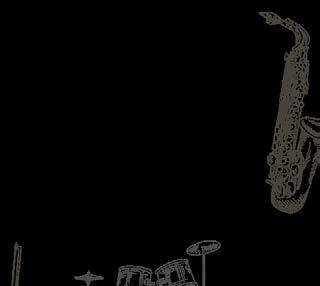
HARP – a plucked stringed instrument consisting of a resonator, an arched or angled neck, can be plucked or played more smoothly - ethereal, clear, and resonant sound often described as angelic or bell-like, with a wide range from highs to lows,

THEMES & TOPICS
MARIMBA– A xylophone of southern Africa and Central America origin that consists of wooden bars with resonators beneath each bar and that are struck by mallets. The National Instrument of Nicaragua- deep, soft, percussive, mellow, restrained yet joyful with a warm and resonant tone
SAXOPHONE – A woodwind instrument often featured in jazz and blues - mellow and smooth to bright and buzzing.
TRUMPET – A brass instrument with a bright, bold sound - loud, bright, and brassy.
BANJO – A string instrument with a twangy tone, common in bluegrass and folk - distinct, often bright and ringing, characterized by a percussive quality and clear projection.
ACCORDION – A keyboard and bellows instrument used in folk and traditional music worldwide - high-pitched, mournful squeal to a rich, deep, or even lasery tone.

FLUTE – A woodwind instrument played by blowing across a mouthpiece, producing a light, airy sound - bright, airy, and clear in its higher register, and mellow and rich in its middle register, while its high notes can be penetrating or shrill.
SOURCE: Instruments - Dallas Symphony Orchestra. (2020, November 7). Www.dallassymphony.org. https://www.dallassymphony.org/community-education/dso-kids/ listen-watch/instruments/


Scan the QR Code to the right to read and listen to “21 Days of Musica Latina: Nicaragua” on NPR.org by Miguel Perez. Nicaragua’s place in the nueva canción movement is top of mind here. Acts like Dúo Guardabarranco, comprising siblings Katia and Salvador Cardenal, added their own socially conscious lyricism to the musical movement that swept through Central America in the ‘80s. Published OCTOBER 4, 2023.

BASSIST TONYA SWEETS IN REHEARSAL FOR LITTLEBOY/LITTLEMAN AT GEFFEN PLAYHOUSE.
PHOTO BY JEFF LORCH.

ACTIVITY: DESIGN YOUR RESTAURANT
In Rudi Goblen’s littleboy/littleman , street performer Fíto shares with his older brother Bastian, that he wants to be a chef and open a “restaurant…that’s gonna sell the healthy dope food people can afford to buy.” Fíto then informs Bastian that he wants his brother to manage the restaurant.
DIRECTIONS: Think about a restaurant that you would want to open, and dream big like Fíto and come up with your Whole Plan to open a restaurant! Opening a restaurant is hard work and a lot of planning! There is a lot to think about in planning and creating a restaurant from concept to opening the doors and serving your first guest! Think about restaurants you like, and what makes them good!
THE FOOD!
What type of cuisine will you serve? Will you use family recipes or create your own? What is the overall concept of your restaurant going to be? (Trendy, home cooking & comfortable ) Create a menu! List 8 dishes you plan on serving, and estimate their cost. (Think of appetizers, salads, entrees, side dishes, dessert, beverages)
TWO
THE SPACE!
What kind of service will you offer? (Fine Dining, Casual Dining, Fast-Casual, Quick Service?) Will your restaurant offer takeout service or delivery?
Think of all the interior design and functional elements of your restaurant. What type of seating will your restaurant have? What kind of flooring will be used in your restaurant? What will be the color of the walls? What art will be on the walls? What type of music will play in the background? Will you have live music?
What will your hours of operation be, and what days will you be open? (Will you serve breakfast, lunch and or dinner? Will you have a late night menu? What would you want your staff to wear at work?
STEP NUMBER THREE
IT’S ALL IN THE NAME!
Where do you want this restaurant to be located? Fíto is going to call his restaurant “Chilo’s kitchen” after their mother. Give your restaurant a name! Design a logo!
Scan the QR Code to the left to read “Here’s What It’s Like to Own a Restaurant” from Toasttab.com. Owning a restaurant has its fair share of ups and downs. Restaurant owners Enga and Matt Stanfield share their experience and advice.


POST-SHOW DISCUSSION QUESTIONS
Depending on the time available and your participants’ interests, guide them to respond to the suggested questions below. Encourage everyone to participate, and respect differing opinions. Individuals can share their thoughts with a partner, in a small group, as part of a bigger group discussion, or as written responses.
• What are some images and moments from the production that stood out or resonated with you? What was meaningful, stimulating, surprising, evocative, memorable, interesting, exciting, striking, touching, challenging, compelling, delightful, different, or unique?
• Overall, how did you feel while watching this show? Engaged? Amused? Inspired? Provoked? Uncomfortable? What made you feel this way?
• Did you identify or empathize with any of the characters in the play? If so, which character(s) and when? If not, why not? Which characters remind you of someone in your life?
• What did you appreciate most about the performance by the actors?
• How well do you know your family’s history of names? Where does your family name comes from?
• What are some of your earliest experiences you remember of hearing family stories being shared?
• What is your favorite restaurant and menu item? Why?
• What is a food you have not yet tried, but curious to taste? Why?
• Describe the design elements from the show: set, props, costumes, music. Be specific as possible: what did you see, hear, feel and experience? How do these design elements inform the storytelling and how do they make you feel as an audience member?
• If you could tell a loved one anything, who would you tell and what would you tell them? Who or what inspires you? Give them a call or write them a letter and share how impactful they were in your life.
TARA RICASA AND SARA PORKALOB AND STUDENTS AT THE STUDENT MATINEE OF DRAGON LADY AT GEFFEN PLAYHOUSE
PHOTO BY ISAAK BERLINER
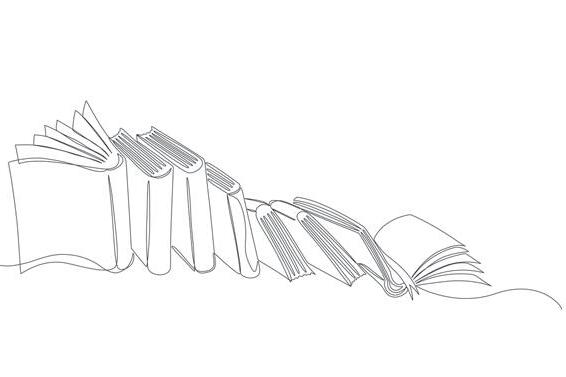
THEMES & TOPICS
IF YOU LIKE THIS PLAY...
If you liked littleboy/littleman by Rudi Goblen, you might also enjoy the plays (and poem) below, which combine rich language, looping or fragmented storytelling, surreal yet grounded plots, reimagined identity and history, experimental forms, and characters who feel both everyday and larger-than-life.
Edward Albee – The Zoo Story (1959)
Visit your local library to check out these writers! www.lapl.org/branches
Two men meet in a park; their conversation spirals into a violent power struggle. Why it resonates: A tight two-hander where shifting dominance, loneliness, and desperation escalate toward tragedy.
Amiri Baraka – Dutchman (1964)
A Black man and a white woman meet on a subway; their interaction becomes a deadly allegory of race and survival. Why it resonates: While not about brothers, its compressed space, explosive dialogue, and inevitable violent climax share littleboy/ littleman’s energy.
Lorraine Hansberry – Les Blancs (1970)
Three brothers confront their roles in colonial resistance and family expectation. Why it resonates: Though broader in scope, some similarities include interest in brotherhood, father-figures, and legacy tied to systemic violence.
Sam Shepard – True West (1980)
Two brothers clash over identity, livelihood, and success while stuck in their mother’s house. Why it resonates: Sibling rivalry, masculinity, and cycles of inheritance found in absurdist Americana.
Ntozake Shange – “Bocas: A Daughters Geography” (1983)
A poem about naming and space and resistance.
Why it resonates: Shange connects supposedly distant & distinct places in a common cartography of solidarity & revolt, reminding the reader of the importance of names and language. Shange reminds us that, although we, in Chicago or San Juan or Luanda or Palestine “cannot speak the same language… we fight the same old men.”
Suzan-Lori Parks – Topdog/Underdog (2001)
Two Black brothers struggle to form a meaningful bond, navigating a legacy of abandonment and betrayal, while in pursuit of the American Dream.
Why it resonates: The sibling dynamics and buried legacies connect to exploration of material and emotional inheritance.
Branden Jacobs-Jenkins – Appropriate (2013)
Adult siblings fight over their late father’s estate, unearthing family secrets and racial histories. Why it resonates: The sibling dynamics and buried legacies connect to exploration of material and emotional inheritance.
Tarell Alvin McCraney - The Brothers Size (2013)
A modern-day fable about two brothers; the elder brother embodies hard work and reliability, while the younger, formerly incarcerated, is seemingly carefree and unpredictable. Why it resonates: Both plays center on brotherhood strained by love, rivalry, and survival. Each play uses lyrical, rhythmic dialogue and a tight, intimate setting to explore cycles of family, masculinity, and destiny.
Antoinette Nwandu – Pass Over (2017)
Two Black men hang out on a city street corner, talking dreams, fears, and survival, with biblical echoes. Why it resonates: A mix of everyday banter using repetition, humor, and looming violence.
Aleshea Harris – Is God Is (2017)
SOURCE: French, S. A. (2025). Samuel A. French | Concord Theatricals. Concord Theatricals. https://www.concordtheatricals.com/a/4346/samuel-a-french
Twin sisters go on a revenge quest, mixing myth, hip-hop cadences, and Greek tragedy. Why it resonates: The sisters’ bond is tight yet combustible. The play explores cycles of violence, inherited pain, and mythic archetypes in contemporary Black life.
ADDITIONAL RESOURCES
BE educated on different types of Busking at https://www.thebrokebackpacker.com/busking-101/
CALL the National Drug Hotline at 1-844-289-0879 if you or a family member needs help.
CELEBRATE Hispanic History Heritage Month from September 15th to October 16th https://tinyurl. com/3j27nnr8
DISCOVER more about Hispanic Heritage Month at https://tinyurl.com/yu4j2tz4
HONOR Hispanic Heritage Month with 8 Unique Documentaries https://tinyurl.com/2c6n26uu
LEARN about Nicaragua’s use of children as soldiers at https://tinyurl.com/4nu8pvz5
LISTEN to Ted Talks in Spanish (with multilingual subtitles) at https://tinyurl.com/cdm9c9jc
READ award-winning poetry like “Poet X” by Elizabeth Acevedo, or “Fresh Banana Leaves: Healing Indigenous Landscapes Through Indigenous Science” by Jessica Hernandez, Ph.D
TEXT or CALL “988” nationwide to connect directly to the Suicide & Crisis Lifeline.
UNDERSTAND how your name can affect your life at https://tinyurl.com/2tz33zeb
WATCH Werner Hertzog’s documentary Ballad Of The Little Soldier at https://www.youtube.com/ watch?v=MdDaQxHq4VE&rco=1
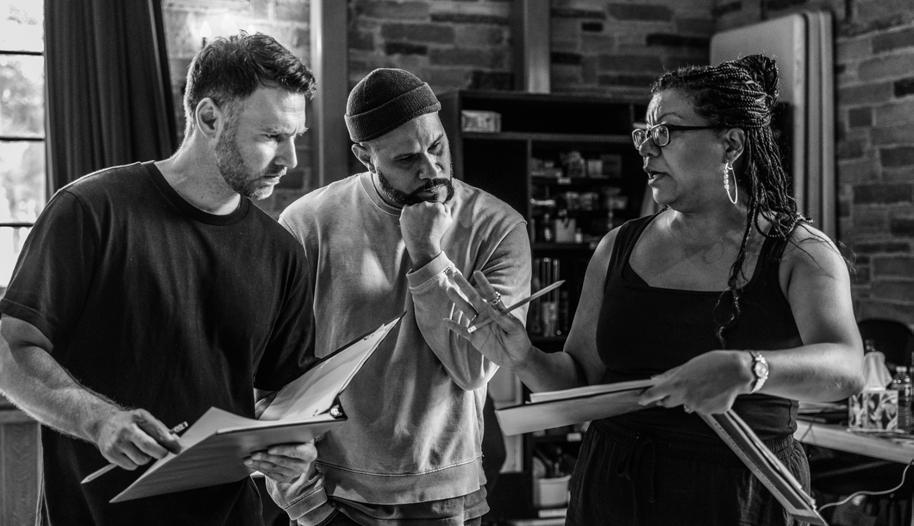
SCAN this QR code to watch videos from American Theatre Wing’s Masterclass series on different jobs in American Theater. Actors, Directors, Movement Directors, Stage Managers, Wig Makers, Scenic Designers, Front of House staff, Marketing Directors and many other people work together to bring a show to life! If you are interested in a career in the arts and work behind the scenes, learn more here. #theater #jobs #alifeinthearts #getintotheatre #americantheatrewing#career #behindthescenes
AUDIENCE’S THE ROLE
What is your important role as an audience member?
Seeing live theater is different from going to a movie theater, watching something at home on your TV, or attending a live sporting event or concert. You are an important part of the experience- just as much as the performers on stage!
What are some things we should keep in mind to ensure that we, other attendees, and the performers have a great experience?
THE THREE R’S
Please be RESPECTFUL!
• Respect the space, the work, and one another.
• Silence phones and put them away during the show.
• Unwrapping candy or cough drops before play begins.
• Respect the artists by not taking pictures or videos during the peformance.
Please be RESPONSIBLE!
• Arrive early to the theater! It can be disruptive to enter the theater after the show has already started, and you will miss some great moments and important parts of the story!
• Remain seated until the end of the show (unless it is a true emergency).
• Eating or drinking before or after the show, or during intermissions.
• Please visit the restroom before or after the show, or during intermissions.
Please be RESPONSIVE!
• Respond genuinely! For example, if you find something amusing, funny, feel free to laugh and react.
U SE OF SOCIAL MEDIA
We appreciate you sharing your Geffen Playhouse experience via social media, and kindly request that you do not do so inside the theater, where the use of electronic devices is prohibited.
We recommend that you post your responses and thoughts in the lobby after the performance, and invite you to tag @GeffenPlayhouse and use #GeffenPlayhouse to share your experience and to continue the conversation with us online.

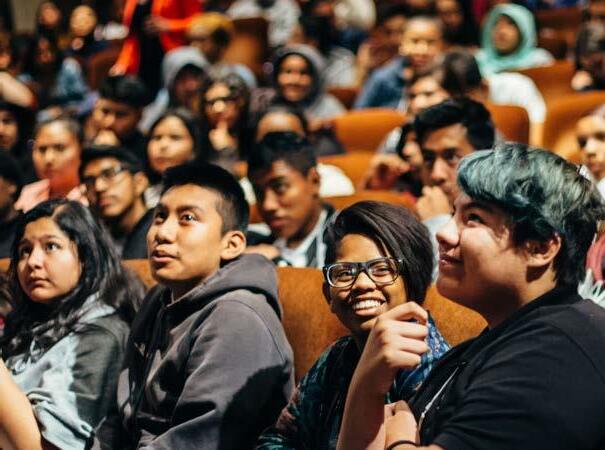
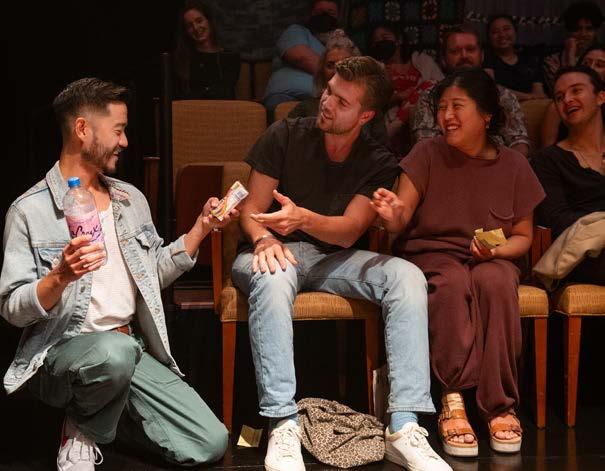

LAUSD STUDENTS AT THE STUDENT MATINEE OF THE LEGEND OF GEORGIA MCBRIDE. PHOTO BY JEFF LORCH
DANIEL K. ISSAC AND AUDIENCE AT EVERY BRILLIANT THING. PHOTO BY ISAAK BERLINER
LAUSD STUDENTS AT THE STUDENT MATINEE OF THE LEGEND OF GEORGIA MCBRIDE. PHOTO BY JEFF LORCH
L–R: GEFFEN PLAYHOUSE ARTISTIC DIRECTOR TARELL ALVIN MCCRANEY, ANGELA LEWIS, AKILAH A. WALKER, KIMBERLY SCOTT AND ASIA MARTIN DURING A TALKBACK FOR A STUDENT MATINEE OF BLACK CYPRESS BAYOU PHOTO BY ISAAK BERLINER.
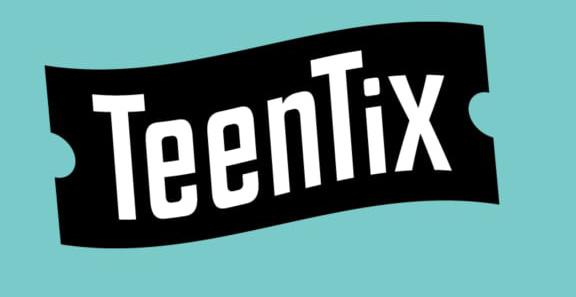
Wanna see more theater? Sign up for the TeenTix LA Pass at LA.TEENTIX.ORG/SIGN-UP
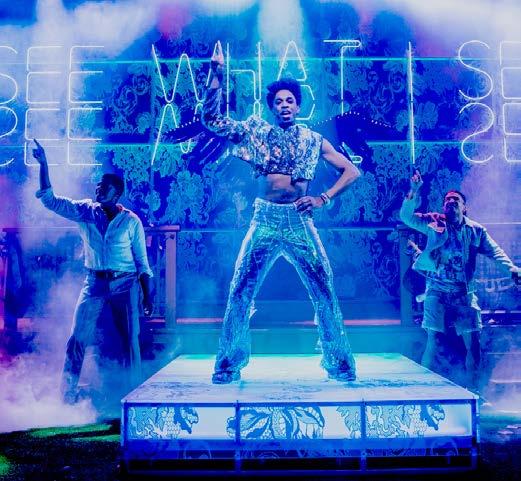
A program for anyone ages 13–19! Once you’re registered, you’ll get access to $5 tickets at over 40 arts organizations, including Geffen Playhouse, Pasadena Playhouse, and Center Theatre Group, and many more. Check out the full list of TeenTix-eligible events at la.teentix.org/calendar!
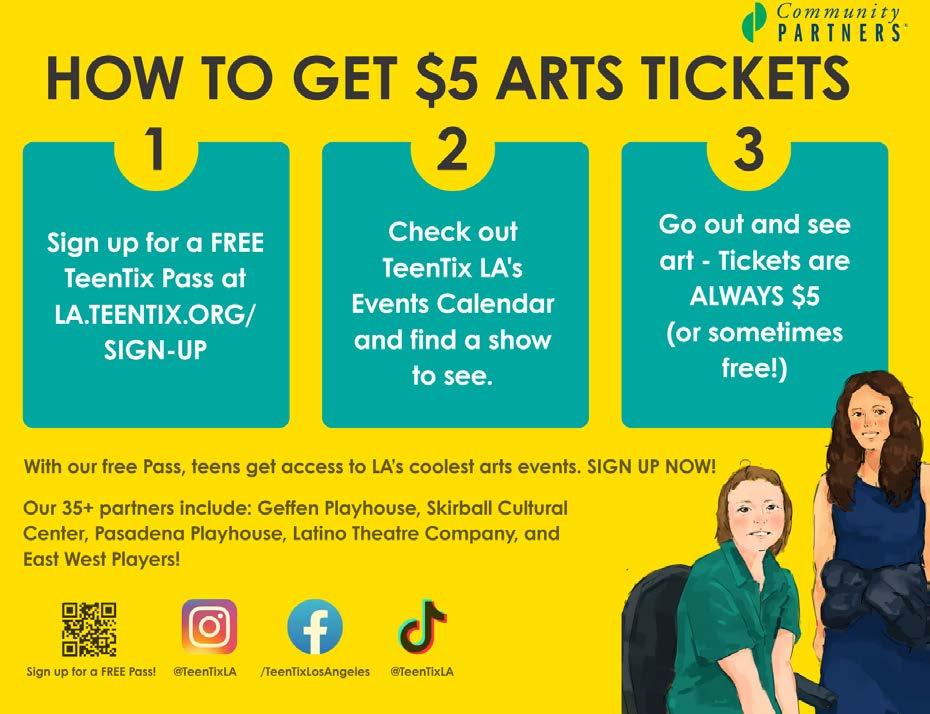
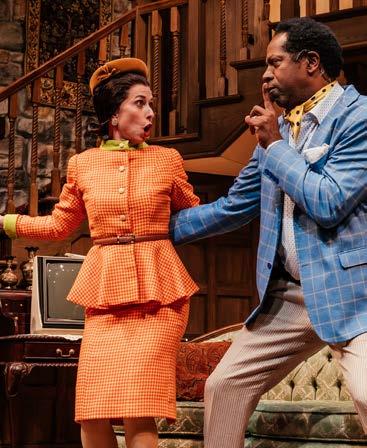
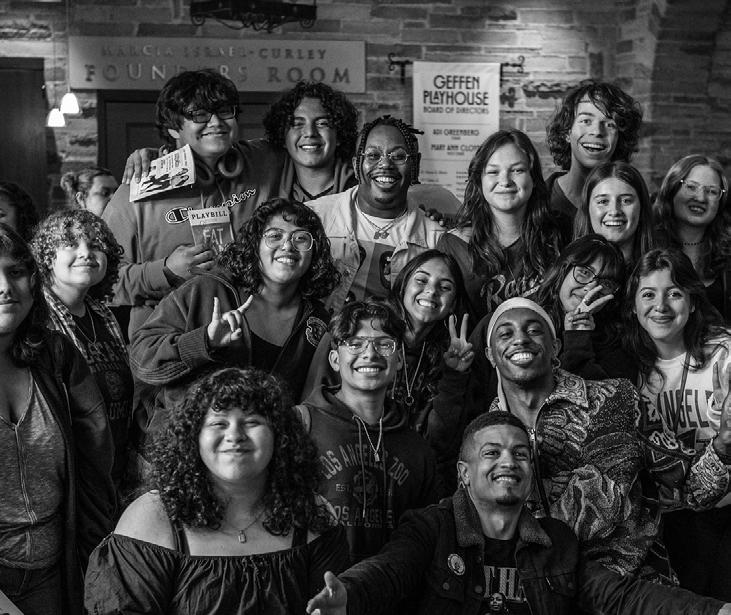
PHOTOS:
TOP, L–R: BILLY EUGENE JONES, MATTHEW ELIJAH WEBB, CHRIS HERBIE HOLLAND, FAT HAM PHOTO BYJEFF LORCH MIDDLE, L–R: AUDREY FRANCIS & JAMES VINCENT MEREDITH IN NOISES OFF. PHOTO BYJEFF LORCH BOTTOM, CLOCKWISE: MARCEL SPEARS, MATTHEW ELIJAH WEBB, CHRIS HERBIE HOLLAND AND LAUSD STUDENTS AT THE STUDENT MATINEE OF FAT HAM. PHOTO BY JEFF LORCH

